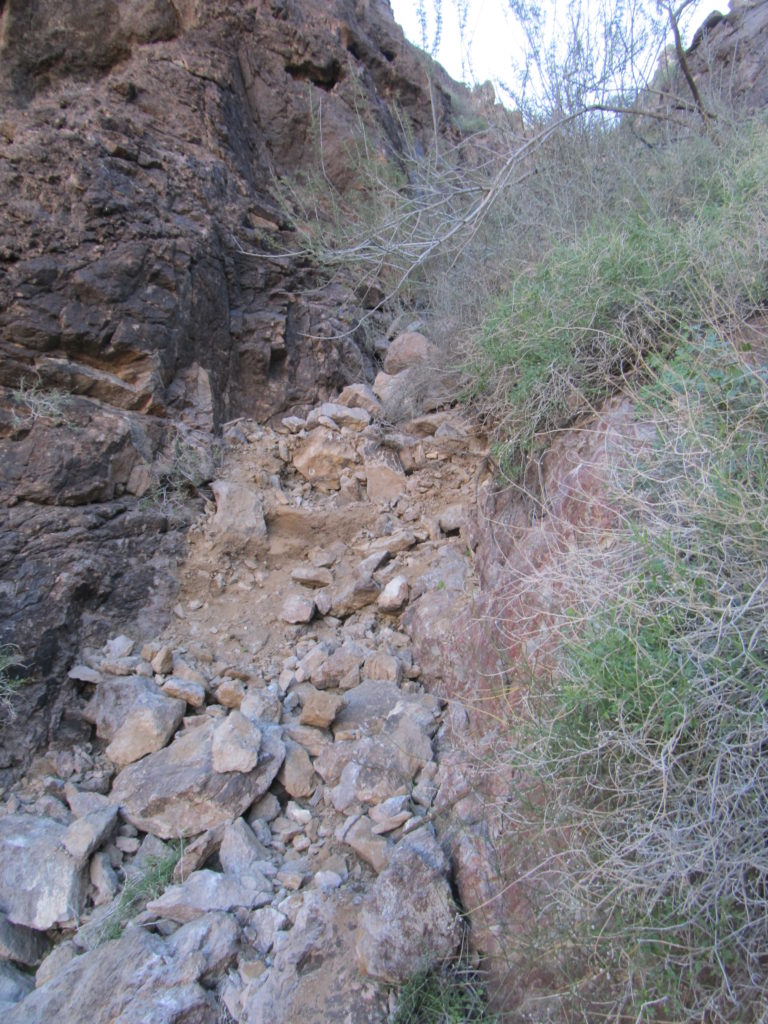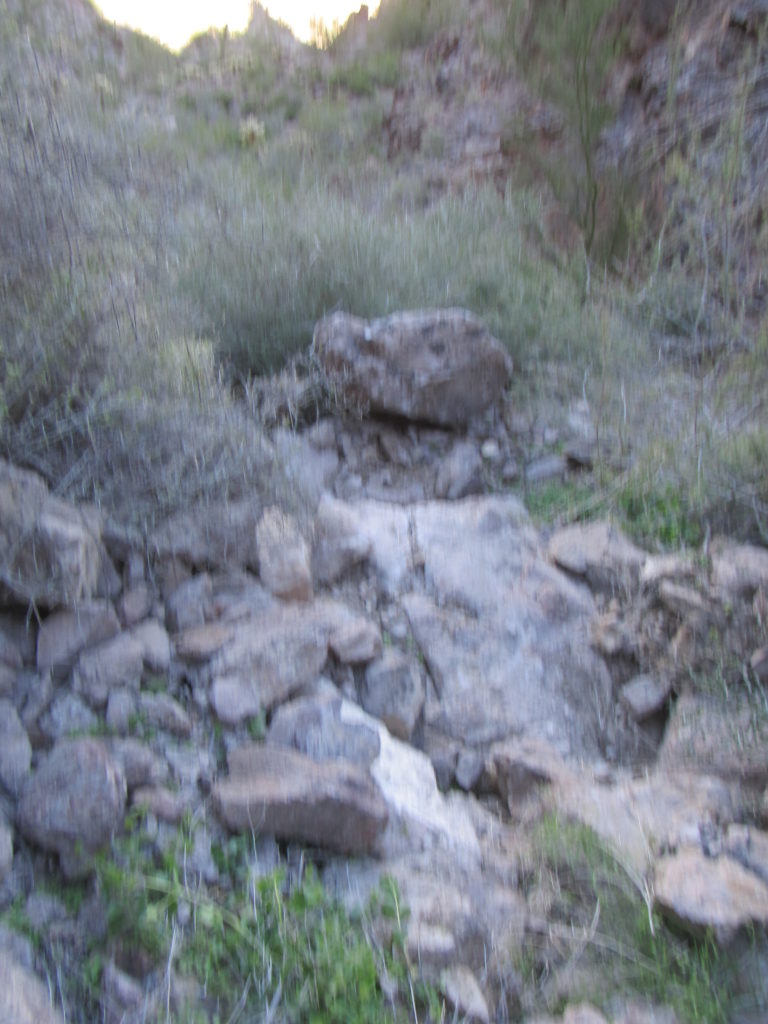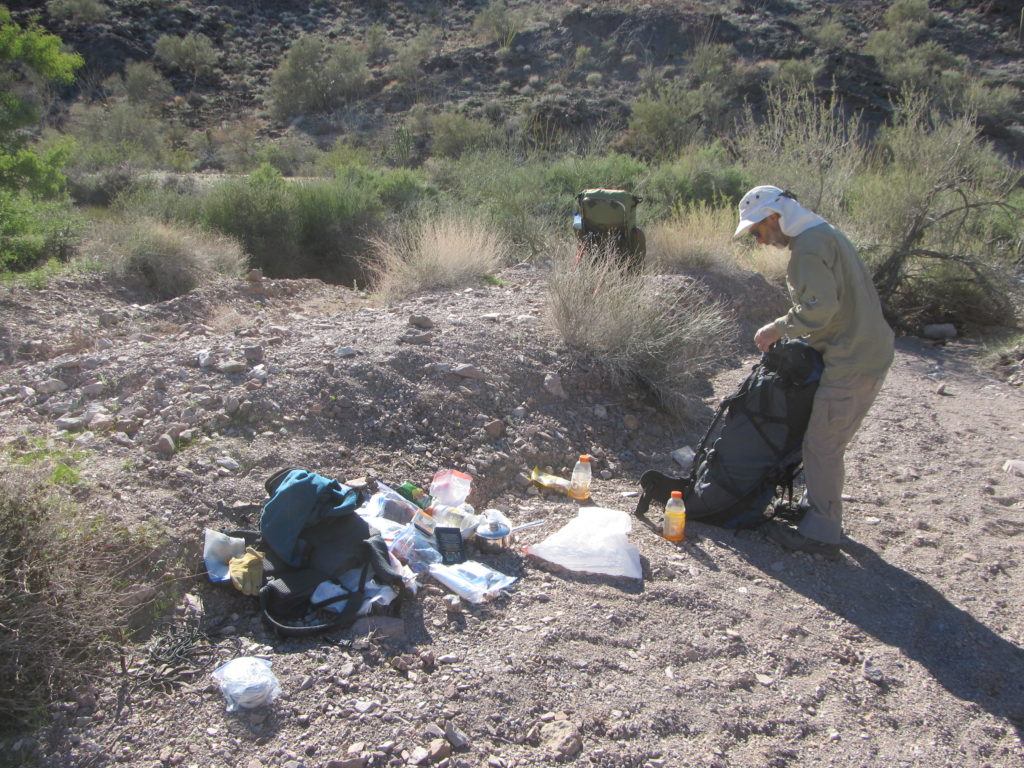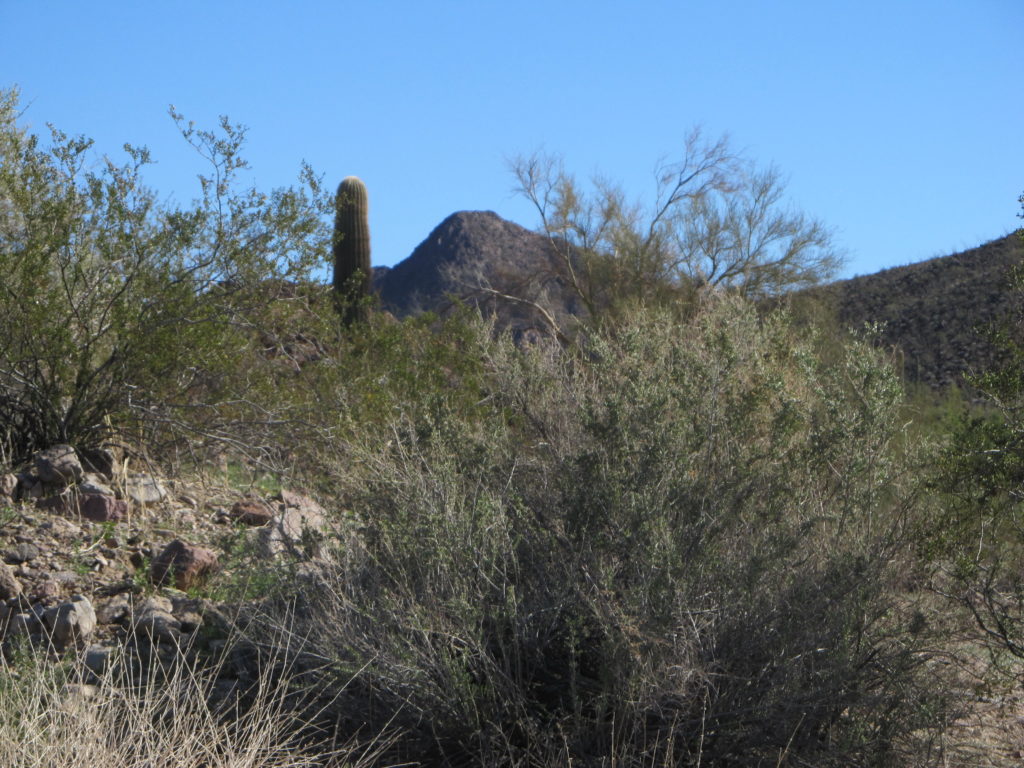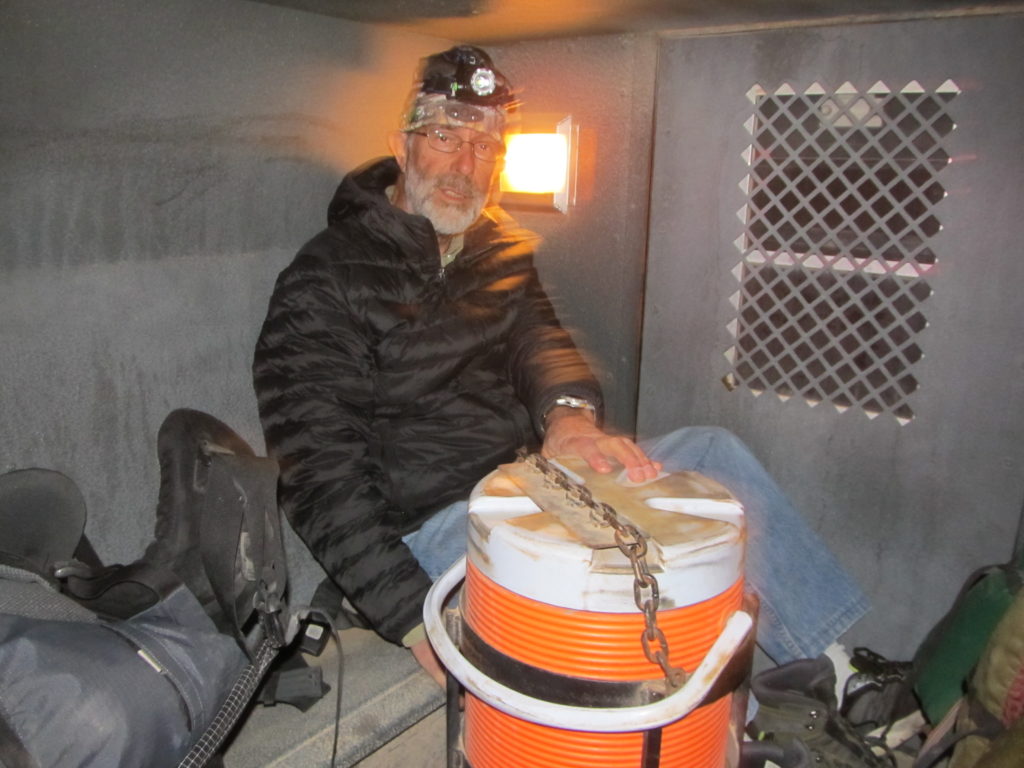Please be sure to read the previous 3 installments of this story before reading this final one.
So here we were, climbing up into a narrow gully in the hope of getting to the top of our mountain. I was a few feet ahead of Luke on a simple Class 2 move, climbing up some easy rock like we’ve done a thousand times before, when all hell broke loose. Before I tell you what happened next, I need to be honest and admit that it has taken me weeks to come to grips with this and be able to write it down. It’s very hard to discuss it even now, but I’ll do my best.
I told Luke that there was a rock that looked loose, about the size of a softball, and that I would give it a push with my foot and roll it down and out of the way. He stepped safely over to the side, I gave it a nudge and it rolled down and stopped a few feet below us. Then I climbed a few feet higher and stood on a huge boulder in the gully. It appeared to me that there was one other rock that looked loose and that I should push it down and out of the way. It was a bit bigger than the last one, and sat below the boulder on which I stood. Luke was still standing to the side and safely out of the way. The instant I touched that rock, all hell broke loose. In a split second, so quickly that I had no time to react, everything was moving under me. I found myself sliding downwards – rocks were moving all around me, to the sides of me and beneath me. There was a lot of noise as rocks rolled against each other. For the most part, my torso was above the fray, while my hips and legs were being buffeted by a lot of rocks. The worst of it, though, was a large rock, about 18 inches across, that rolled over my right arm, crushing it against the rocks underneath it.
Within a few seconds, it was over. All the rocks stopped moving, and so did I. I felt an unbelievable pain in my arm, unlike any pain I’d ever felt in my life. My immediate thought was that my poor arm had been mangled, and I feared the worst. I was lying on my left side on a jumble of rocks. I vaguely remember saying something like “Oh my God, oh my God” over and over again. When I looked at my hand, I saw the flesh torn open at the base of my thumb and a lot of blood. I was afraid to look under my shirt sleeve up closer to my elbow to see what damage had occurred, but I knew it must be much worse than my thumb. I was so much a part of the rockslide, so caught up in it, that I couldn’t see everything that happened, but Luke saw it all from a safe vantage point a few feet away. He has kindly penned his thoughts and allowed me to present them here to you in italics. From here on out, my words will be in regular type and Luke’s will be in italics, and the story will move back and forth between the two of us.
At first glance from afar, the peak looked simple, like many nearby we planned to climb. As we approached a saddle on the peak’s northwest ridge, it appeared that
the northwest ridge and west face had a steeper profile and cliffs than we anticipated from afar. Clearly, there were no simple routes at this point, so we traversed around to a canyon on the peak’s northeast side where it narrowed into a gully. Stopping for a break, perhaps no more than 300 vertical feet below the summit, we viewed a possible route, a continuation of the gully, that proceeded southeasterly towards the summit plateau.
It appeared typical Class 2 with moderate brush. So, after our break, we proceeded
up the narrowing gully, zig-zagging around brush to where the gully narrowed
between a prominent cliff on the left and a rock outcropping on the right. The gully at this point was perhaps three to four feet wide with a collection of tenuous rocks in between.
As we approached this “pinch”, DM was in the lead and all at first appeared rather typical. He dislodged a loose rock, the first, somewhat innocuous, an omen perhaps of what was to come, that tumbled down the gully a few feet. Not much larger than a softball, it stopped just a few feet below where we were climbing. At this point, we were but 200 vertical feet below the summit.
DM climbed up a few more feet in the rocky gully, now standing on a large,
oval-shaped boulder, that was embedded in soil at perhaps a 30-degree angle. Just below this oval-shaped boulder was another basketball-sized rock that was, as we were to learn, the “king-pin” that the boulder that DM was standing on was resting. Appearing loose, DM said “I’m going to kick this rock down”. So, I moved up and away in precaution.
As soon as DM kicked out this rock, a cascading rockfall launched, including the large boulder he was standing on and other loose rocks and debris that was deposited atop the large boulder. It was chaotic as I witnessed DM’s out-of-control fall, and fortunately, the large boulder dropped, after he “rode” it a foot or two, past and then below me while he was able to hang on to the ground above him where various rocks and debris pummeled his right arm and hand. The large oval-shaped boulder continued downhill and eventually stopped perhaps 30 feet below us. The rockfall all happened within a 5 to 10 second time span, but it was still, nonetheless, horrific to witness as the uncertainty of what would or wouldn’t happen as rockfalls can have cascading behavior. Luckily, this was relatively contained, yet there was enough damage to DM’s body to engage shock as he grabbed his right arm, writhing in tormenting pain enough to cause him to weep.
After the dust settled and rocks stopped falling I moved over to DM where I was uncertain what to do next with the possibility of more residual rocks raining down the gully. Furthermore, I wasn’t certain of the extent of DM’s injuries, but certainly his right arm sustained damage as evidenced by the blood seeping through his shirt. After a few calming minutes, he was able to move, thankfully, with no apparent mobility problems in his lower body. We moved to a safer place, an alcove nearby, perhaps at most ten feet from the gully, where DM went into shock, curled up in the fetal position, gripping his right arm and weeping.
It was about 11:10 AM and fortunately daylight was on our side. Clearly, DM needed to rest and recover somewhat from the immediate crisis. I comforted him as best I could with the reassurance we’d get down the mountain and to safety. I fumbled through his day pack to combine his first aid kit and mine, as his right arm had two large bleeding contusions, the worst below the elbow about the size of a pancake, the second, smaller, on the top of his right hand above the thumb and forefinger. We later noted a variety of cuts and scrapes on his side and legs and what would develop into a huge bruise on his left torso under the rib cage.
I remember lying on the rocks when they had stopped moving. Luke had moved over to me and I could hear his voice – he was praying aloud, begging that I would be okay. He helped me to my feet and over to the safety of the nearby alcove. I have no idea how long I lay there, but I could hear him rummaging through our first aid kits. He applied a large butterfly bandage to my hand and I took a couple of Aleve. After a while, I had calmed down somewhat and felt I could sit up. He put our day packs back together and we prepared to leave. Here is a photo of the exact spot where the accident occurred. All of the light brown area in the center of the photo is where the rocks loosened and fell.
Luke had been concerned, rightfully so, that more rocks could come rolling down the gully. Fortunately, none did after the initial rockslide, and the alcove was safely out of the line of fire. Once I was able to stand, we knew that the first thing we had to do was to get safely down the mountain. Luke walked ahead of me – he reached back and held my good hand, as I was still very shaky, and supported me down the steep slope. We had only gone a few feet when we came to the huge boulder I’d been standing on when the slide started. It was enormous, shaped like a huge egg fully 6 feet long. There it sat, out in the open about 30 feet below the site of the accident. Out of curiosity, Luke gave it a nudge and it actually moved! Look at this next photo – the boulder is out in the open, just above the center of the photo. We are looking down the canyon – the bright spot at the top is a sunny area in the distance. Thinking back on it, the boulder had looked firmly embedded in the gully and certainly didn’t look loose or ready to fall – if it had seemed that precarious, I never would have loosened the rock below it nor even stood on it. The boulder is a full 6 feet long and 4 feet wide, and the geologist in me calculated its weight to be about 7,500 pounds.
Luke’s comments continue here:
After DM had recovered somewhat from the shock, we both breathed a sigh of relief knowing that he could walk, albeit very slowly and cautiously into the nearby alcove. The debris fall had stopped and I had assessed the situation as best I could as I still wasn’t certain if there was any unseen internal damage that might incapacitate DM and require a helicopter rescue. He had his inReach rescue device and that option was on the table had we needed it. We then proceeded to bandage his lacerations with butterfly bandages and medical tape. His right arm had begun to swell up about 20-30% and he was in moderate pain. Best we could tell, no broken bones anywhere, just massive contusions, bruises and lacerations on his right arm that was essentially “disabled” for any climbing or descending. Clearly, the trip was over and the focus was on a safe evacuation back to medical attention – that was the priority.
It was about 11:45 and I felt relieved that DM was alert, talking and appearing focused on our descent. His wounds were contained with his lacerations seeping blood but none appearing to require stitches or be life threatening. So, we rested a little longer, he took some Aleve for the pain and I packed as much as I could into my day pack to lighten his pack as much as I could.
Our next objective was to descend the gully, then the canyon and back to the wash and eventually our backpacks. I stuffed as much of our combined gear into my day pack as possible in order to minimize DM’s pack’s weight. He stood up, a bit wobbly at first, testing his balance, his right arm dangling and useless for support. We decided it was time to go. Every step down was assessed and deliberate as we went hand in hand, DM leveraging on me for support. It was slow going but we eventually descended to flatter ground where we reached the upper wash. DM was in pain but I was relieved that he was mobile and alert. I kept asking him how he was feeling so I could determine his pain and disposition as there was still much uncertainty. We kept walking the wash back to our backpacks, DM now able to walk unassisted. Our next objective was how best to get back to our vehicles.
He led me down the canyon, then over a gentle saddle. At that point, we were back in the sunshine, and it felt good – the accident site was deep in shadow, a somber, gloomy place that I couldn’t wait to leave behind. Once past the saddle, the terrain was easy and I walked on my own. It was about 2 miles to walk back down the wash, all of it easy going. Within a quarter of a mile of where we’d left our big packs, we found something which really surprised us – a natural tinaja, or water-hole, in the wash itself, filled with what must have been a thousand gallons of beautiful, clear water – and a couple of smaller tinajas nearby. If only we had known about this, we could’ve avoided those arduous carries of water that we had made. Of course there was no way of knowing that water was there in advance, but it certainly would have changed the logistics of our trip.
Everywhere we went on this trip, we had been seeing donkey poop, and a lot of it was very fresh. In the washes, on the hillsides, in every valley. Every day, we wondered where they were – we never saw any. You can hear them from quite a distance, and their braying is unmistakable, but we never heard any. Something else we discussed was that they had to be finding water somewhere, but where? The tinajas we had just found were an indication that there must be natural water supplies out here. Some might be seasonal, but enough of them must be out there for the donkeys to survive.
We returned to the main wash where we had dropped our backpacks. DM disposed of all his unessential gear from his backpack. It was relieving to see that he was able to function to the point of sorting through his pack and carry on a conversation. I was still anxious about any unseen injury that may have had a delayed reaction. Fortunately, this was not to be the case. We donned our backpacks and began the hike back to road’s end.
We ended up back at Camp Three, and it broke my heart to have to say goodbye to that beautiful spot. Soon afterwards, we reached our big packs right where we’d left them. All the way down the wash, we’d been discussing what we would do next. There was no question in my mind that the climbing was over for me – I needed to seek medical attention. Because I could walk, we decided that the best thing we could do was to head all the way back out on foot right away. I knew I didn’t want to carry any more weight than necessary, so I discarded everything I didn’t need, keeping only the bare essentials. Out went the food, cooking pot and fuel, extra clothing, day pack and many other items. Luke put it all in a bag and set it on the side of the wash. This cut the weight of my pack in half, but it still felt heavy. Here I am setting aside things I don’t want to carry out.
From this spot, we had a last look at the peak where the accident had occurred.
Our next decision was what to do once we were back at road’s end, which was still 7 miles from our parked vehicles. We estimated we’d not return to road’s end until about 5:00 PM and the hike back to our vehicles would surely be in the dark. We had been discussing various options during our hike back to the packs. Our first and ideal option was to call the US Border Patrol station where we had parked our vehicles since we had already confirmed we had cell coverage at road’s end where we had camped several nights before.
We set out, making the slow, steady, uphill trudge up the main wash. In time, we reached our Camp Two, but after a very brief rest we continued. Up to the head of the valley, then over the saddle and down we went into the next drainage. By about 5:00 PM, we had made it all the way back to Camp One. We had had plenty of time to discuss our possible options from there. One was that Luke would walk out with the lightest day pack imaginable and back to our vehicles. He would then drive my truck back in to pick me and our gear up, then take us back out to his vehicle – then we could each drive home. The very best outcome, though, one we discussed at length and were really hoping would happen, was this – we could get someone to come in and pick us up. After all, Camp One was at the end of a rough road.
Luke could have walked cross-country – the shortest route was about 4 miles, but that’d be tough in the dark, even with GPS and maps, as he’d have to negotiate some tricky, unknown terrain. The safest way would have been to follow roads all the way, about 7 miles. I would have had to wait several hours, but at least there would have been no effort from my side. When we reached Camp One, he was able to get a cell-phone connection. We had kept with us the number for one of the major Border Patrol stations, so we called it and asked them to connect us with the checkpoint out on the highway where we’d parked our vehicles 5 days earlier. We told them we had an issue and needed to speak to them, and they connected us right away. I told the agents at the checkpoint that I had injured my arm in a climbing accident, and we would be really grateful if they could come and take us back to our vehicles (I reminded them that the 2 civilian vehicles parked by their station were ours). I knew that this was a real stretch, to ask for such a favor – they owed us nothing.
It took us several hours to return to road’s end, DM doing better than expected as we hiked up the wash and over an easy pass. We were relieved to reach road’s end where we had cached water and food. But more important, we were able to call a Border Patrol station.They in turn provided us with the phone number to their highway checkpoint who we called for help. At this point, I have to praise the United States Border Patrol. We told the agent who answered the phone our predicament and he immediately said “we will help you, stay where you’re at and be sure your phone is on.” Hearing this was an enormous relief as rescuing civilians is not typically within the Border Patrol’s purview. Our conversation continued with details of our location. Some minutes later, a BP agent called us from his vehicle seeking specifics about our location. I can’t describe how relieved we both were as DM’s arm was still in pain, bleeding and with much uncertainty about the extent of his injury. It took a couple of calls to help guide the Border Patrol to our location. We eventually saw their headlights and red/blue emergency lights as we flashed our headlamps back as a beacon for them to find us. It was about 6:30 PM, at the cusp of dusk, when they reached us. Two USBP agents emerged from their truck and we were gushing with thanks.
Let me backtrack for a moment. When the accident occurred, had it been impossible for us to self-evacuate, we would have had little choice but to have pressed the SOS button on my satellite rescue device and call for help. In so doing, we would have been announcing to the world that we were deep inside a forbidden military preserve and could they please mount a rescue to save my sorry ass. To say that this would have been embarrassing and could have brought consequences crashing down upon us would be an understatement. As it was, our Camp One was miles inside the out-of-bounds area of the military preserve, and we were asking the Border Patrol to ignore the military warning signs and come and get us. They didn’t even hesitate.
When they left their checkpoint, they stayed on the phone with us for a while because the start of the road leading to us was very hard to find. You’d need detailed topographic maps and GPS (and satellite photos wouldn’t hurt either) to find the road. We had all of that, but the Border Patrol had none of it. Finally, in the growing darkness, by phone we got them to the right start of the road and they were on the way. After a while, they called us again. They said they had their emergency lights turned on, the ones atop their vehicle that flash red and blue, and could we see them yet? No, but we would turn on a powerful flashing strobe on my climber’s headlamp to help guide them to us. Before too long, we spotted each other – soon afterwards, they pulled up to where we stood near the end of the road. To say that we were never so glad to see someone would be an understatement.
After telling them about our circumstances, we loaded our backpacks and ourselves into the “cage”. We were beyond grateful to be rescued. These USBP agents were very professional and concerned about our welfare. Despite the utility of the cage, we were warm and comfortable for the bumpy ride back to pavement and our vehicles at the BP checkpoint station.
They got out and helped us with our gear. The only place they could put us was in the back of their vehicle in a secure area they called “the cage” – this was where they locked prisoners that they had to transport. It had a metal bench on each side, and a water jug. We were locked in. They had turned on the light and the heat for us. The ride out on the 4WD road was rough and wonderful – we were so glad to be getting out. Here’s a photo Luke took of me in the cage.
Less than an hour later, they unlocked the cage doors and we stepped out into the chill night air at the checkpoint. We thanked them profusely for their help. The agent in charge looked at my injuries and said that I should get medical attention – he asked if I wanted them to call an ambulance, but I declined. During the many hours I’d had to ponder my situation, I’d decided that I’d make my way back to Tucson and get things looked at there, close to home where it’d be a lot more convenient. Right now, there was another problem – my truck was low on gas. Due to poor planning on my part, I’d arrived this far and my tank was almost empty. It was too late to take care of that now, so we decided to camp for the night near the highway. I was afraid that the pain in my arm would prevent me from lying down in my sleeping bag, so I decided to sleep sitting up in the cab of my truck with the bag over me for warmth. It was a rough night, practically sleepless.
DM was stable despite his still-oozing wounds, so there was no need for an EMT at this point although the BP agents made that offer. It was about 7:30 PM. We decided to drive south a couple of miles and camp.
Day 6
The next morning, I awoke to find the sleeve of my shirt stuck to the open wound on my arm – no worries, I’d deal with that later. It turned out that my insurance had a roadside assistance benefit, so I called them and requested that they bring me some gasoline, but for some bizarre reason they would only bring 2 gallons. Fine, just bring it! While we waited, it seemed worthwhile to go over to a motor home parked nearby and see if they had any extra gas they could sell me. The owner, a retiree from Oregon, came out to talk to us. He had a couple of gallons to spare, and he poured it into my tank. Moreover, he wouldn’t take any money for it, not a penny – I resolved to pay his kindness forward at the first opportunity. The wrecker soon arrived with my 2 gallons and then headed back to the city.
Luke and I convoyed back to the city, where we ate a meal and gassed up. The weather was threatening as we parted company, heading in opposite directions. I drove through cold, rainy weather all the way back to Tucson. En route, I called my wife – I had been dreading the call, unsure what I should tell her. “We cut the trip short because I hurt my arm. I’m driving home, but could you call around and find an urgent care facility that’s open and take me there when I arrive.” She took it well. By 4:00 PM on New Year’s Eve, I was sitting and having my wounds dressed, starting down the road to recovery.
Our trip had still been a success. Granted, it was only half of what we’d hoped to accomplish, but even so we had climbed 8 of our objectives. The area we had visited was pristine and beautiful, more so than other remote places where we’d done such long trips. Something had changed, though – neither of us will ever look at a mountain the same way again.

